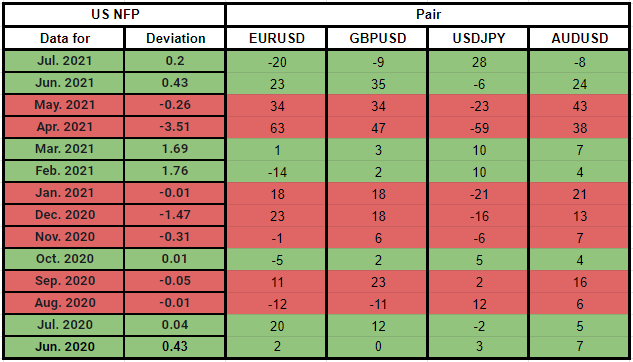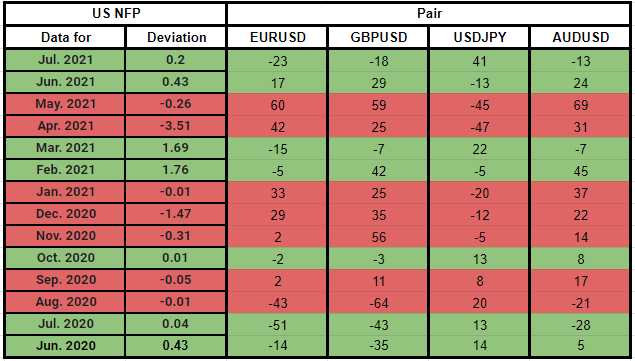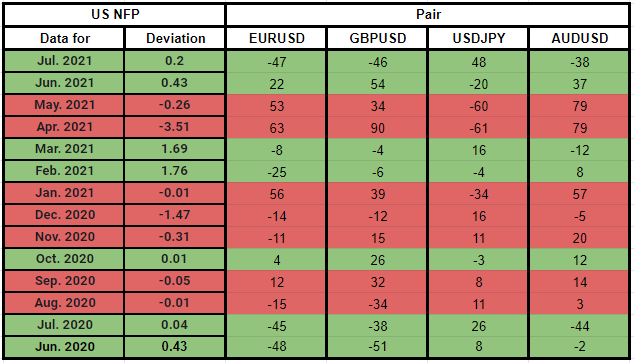- Nonfarm Payrolls in US is expected to rise by 750,000 in August.
- There is a strong correlation between surprising NFP prints and major pairs' immediate movements.
- Investors are likely to react to a disappointing NFP more strongly than a positive reading.
The US Bureau of Labor Statistics (BLS) will release the August jobs report on Friday, September 3. Following an increase of 943,000 in July, investors expect Nonfarm Payrolls to rise by 750,000 and see the Unemployment Rate edging lower to 5.2% from 5.4%.
The monthly data published by the Automatic Data Processing (ADP) Research Institute revealed on Wednesday that employment in the private sector rose by 374,000 in July. This reading missed the market expectation of 613,000 by a wide margin and could be taken as a sign that the NFP could fall short of the market consensus as well.
After FOMC Chairman Jerome Powell refrained from delivering a timeline on asset tapering, the greenback came under strong selling pressure with investors starting to price in a possible delay to a reduction in asset purchases. A better-than-expected NFP print could revive expectations for the Fed to start tapering before the end of the year and trigger a USD rally. On the other hand, a negative surprise is likely to force the USD to continue to weaken against its major rivals.
In order to understand how impactful the US jobs report is on the USD’s market valuation, we analyzed the market reaction of four major pairs, EUR/USD, GBP/USD, USD/JPY and AUD/USD, to the previous 14 NFP prints. We omitted the older NFP figures because we believe the numbers registered during the coronavirus outbreak created extreme outliers and distorted the results.
Methodology
The FXStreet Economic Calendar assigns a deviation point to each macroeconomic data release to show how big the divergence was between the actual print and the market consensus. The -3.51 deviation seen in April's NFP reading could be assessed as a relatively big negative surprise. On the other hand, February’s NFP print of 536,000 against the market expectation of 182,000 was a positive surprise with the deviation posting 1.76 for that particular release.
Next, we plotted the reaction, in terms of pips, of the major pairs mentioned above 15 minutes, one hour and four hours after the release to see if the general market view held.
Finally, we calculated the correlation coefficient (r) to figure out which major pair had the strongest correlation at which time frame. When r approaches -1, it suggests there is a significant negative correlation, while a significant positive correlation is identified when r moves toward 1.
Results
There were seven negative NFP surprises and seven positive surprises in the previous 14 releases. On average, the deviation was -0.8 on disappointing prints and 0.65 on upbeat figures. 15 minutes after a negative surprise, the average gains in the EUR/USD, GBP/USD and AUD/USD were 19.4, 19.3 and 20.5 pips, respectively, while USD/JPY lost 15.8 pips. On the other hand, EUR/USD, GBP/USD, USD/JPY and AUD/USD rose 1, 6.4, 6.8 and 6.1 pips, respectively, on average following positive surprises. These findings suggest that investors are more likely to react immediately to weaker-than-expected NFP prints rather than strong ones.
15-min deviation table
60-min deviation table
240-min deviation table
EUR/USD
EUR/USD has a correlation coefficient of -0.77, -0.46 and -0.47 15 minutes, 60 minutes and 240 minutes after the release, respectively. These numbers suggest that the impact of the NFP deviation on EUR/USD fades away following a strong reaction initially.
GBP/USD
GBP/USD has a correlation coefficient of -0.58, -0.17 and -0.48 15 minutes, 60 minutes and 240 minutes after the release, respectively. These numbers suggest that there is a relatively strong inverse correlation with the pip-change in GBP/USD and the NFP deviation 15 minutes after the release. However, this correlation is virtually non-existent one hour after the release as presented by the flattening trend line seen in the respective chart.
USD/JPY
USD/JPY has a correlation coefficient of 0.79, 0.56 and 0.43 15 minutes, 60 minutes and 240 minutes after the release, respectively. These numbers suggest that the NFP deviation has a strong positive correlation with the pip-change in USD/JPY 15 minutes and one hour after the release.
AUD/USD
AUD/USD has a correlation coefficient of -0.52, -0.16 and -0.45 15 minutes, 60 minutes and 240 minutes after the release, respectively. These numbers suggest that the inverse correlation with the pip-change in AUD/USD and the NFP deviation 15 minutes after the release is weaker than it is for EUR/USD and GBP/USD. Similar to GBP/USD, AUD/USD shows no interest in the NFP print one hour after the release.
Summary
To summarize, a negative NFP surprise triggers a stronger market reaction than a positive one in EUR/USD, GBP/USD, USD/JPY and AUD/USD pairs. There is a significant correlation between the NFP deviation and pip-change in these pairs immediately after the data release. One hour later, the correlation weakens noticeably in these pairs with the exception of USD/JPY. Four hours after the release, it's difficult to draw a connection between these pairs' movements and the NFP reading.
Information on these pages contains forward-looking statements that involve risks and uncertainties. Markets and instruments profiled on this page are for informational purposes only and should not in any way come across as a recommendation to buy or sell in these assets. You should do your own thorough research before making any investment decisions. FXStreet does not in any way guarantee that this information is free from mistakes, errors, or material misstatements. It also does not guarantee that this information is of a timely nature. Investing in Open Markets involves a great deal of risk, including the loss of all or a portion of your investment, as well as emotional distress. All risks, losses and costs associated with investing, including total loss of principal, are your responsibility. The views and opinions expressed in this article are those of the authors and do not necessarily reflect the official policy or position of FXStreet nor its advertisers. The author will not be held responsible for information that is found at the end of links posted on this page.
If not otherwise explicitly mentioned in the body of the article, at the time of writing, the author has no position in any stock mentioned in this article and no business relationship with any company mentioned. The author has not received compensation for writing this article, other than from FXStreet.
FXStreet and the author do not provide personalized recommendations. The author makes no representations as to the accuracy, completeness, or suitability of this information. FXStreet and the author will not be liable for any errors, omissions or any losses, injuries or damages arising from this information and its display or use. Errors and omissions excepted.
The author and FXStreet are not registered investment advisors and nothing in this article is intended to be investment advice.
Recommended Content
Editors’ Picks

EUR/USD remains offered in the low-1.0900s
The generalised selling pressure continues to weigh on the risk complex, pushing EUR/USD back toward the 1.0900 support level amid a growing risk-off mood, as traders assess President Trump’s reciprocal tariffs and their impact on economic activity.

GBP/USD retreats further and breaks below 1.2800
The US Dollar is picking up extra pace and flirting with daily highs, sending GBP/USD to multi-week lows near 1.2770 in a context where safe-haven demand continues to dictate sentiment amid the chaos of US tariffs.

Gold recedes to four-week lows near $2,950
The persistent selling pressure is now dragging Gold prices to the area of fresh multi-week troughs near the $2,950 mark per troy ounce, always amid the continuation of the recovery in the US Dollar, highr US yields across the curve and unabated tariff tensions.

US stock market suddenly reverses higher after rumor of 90-day tariff pause before sinking again Premium
NASDAQ sinks 4% before shooting higher on tariff pause rumor. CNBC says White House unaware of tariff pause rumor. S&P 500 sinks to January 2024 level. Bank of America cuts its year-end target for S&P 500 by 16%.

Strategic implications of “Liberation Day”
Liberation Day in the United States came with extremely protectionist and inward-looking tariff policy aimed at just about all U.S. trading partners. In this report, we outline some of the more strategic implications of Liberation Day and developments we will be paying close attention to going forward.

The Best brokers to trade EUR/USD
SPONSORED Discover the top brokers for trading EUR/USD in 2025. Our list features brokers with competitive spreads, fast execution, and powerful platforms. Whether you're a beginner or an expert, find the right partner to navigate the dynamic Forex market.











